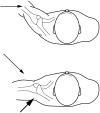Shoulder injuries in tennis players
- PMID: 16632575
- PMCID: PMC2577490
- DOI: 10.1136/bjsm.2005.023218
Shoulder injuries in tennis players
Abstract
The mechanism of the overhead action in throwing sports has been studied extensively. This motion is unnatural and highly dynamic, often exceeding the physiological limits of the joint. Owing to overload of various anatomical structures, the shoulder is susceptible to injury. Optimal shoulder function requires good kinetic chain function, optimal stability, and coordination of the scapula in the overhead action. A well balanced action of the rotator cuff muscles and capsular structures is necessary to obtain a stable centre of rotation during the overhead action. This review concerns shoulder injuries, related to the overhead motion in tennis players, which can be explained by the same mechanism as thrower's shoulder.
Conflict of interest statement
Competing interests: none declared
References
-
- Kibler W B. Biomechanical analysis of the shoulder during tennis activities. Clin Sports Med 19951479–85. - PubMed
-
- Burkhart S S, Morgan C D, Kibler W B. The disabled throwing shoulder: spectrum of pathology. Part III. Arthroscopy 200319404–420. - PubMed
-
- Kibler W B. The role of the scapula in athletic shoulder function. Am J Sports Med 199826325–337. - PubMed
-
- Gagey O J, Gagey N. The hyperabduction test: an assessment of the laxity of the inferior glenohumeral ligament. J Bone Joint Surg [Br] 20018369–74. - PubMed
-
- Halbrecht J L, Tirman P, Atkin D. Internal impingement of the shoulder: comparison of findings between the throwing and nonthrowing shoulders of college baseball players. Arthroscopy 199915253–256. - PubMed
Publication types
MeSH terms
LinkOut - more resources
Full Text Sources
Medical








